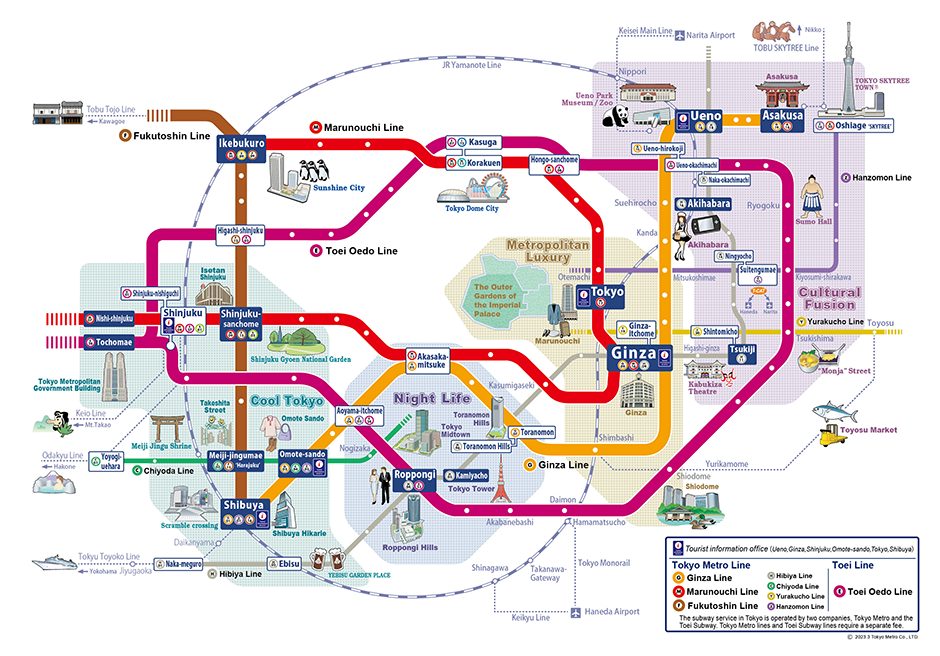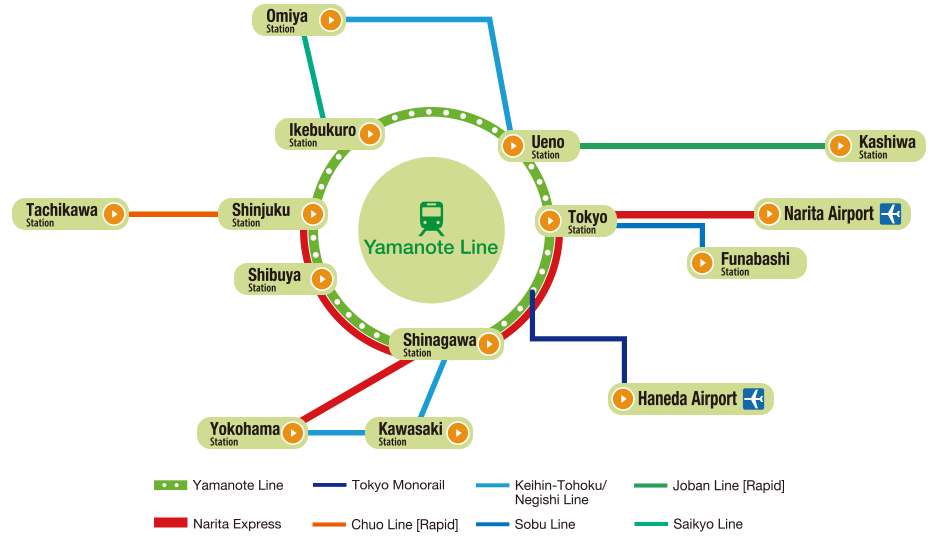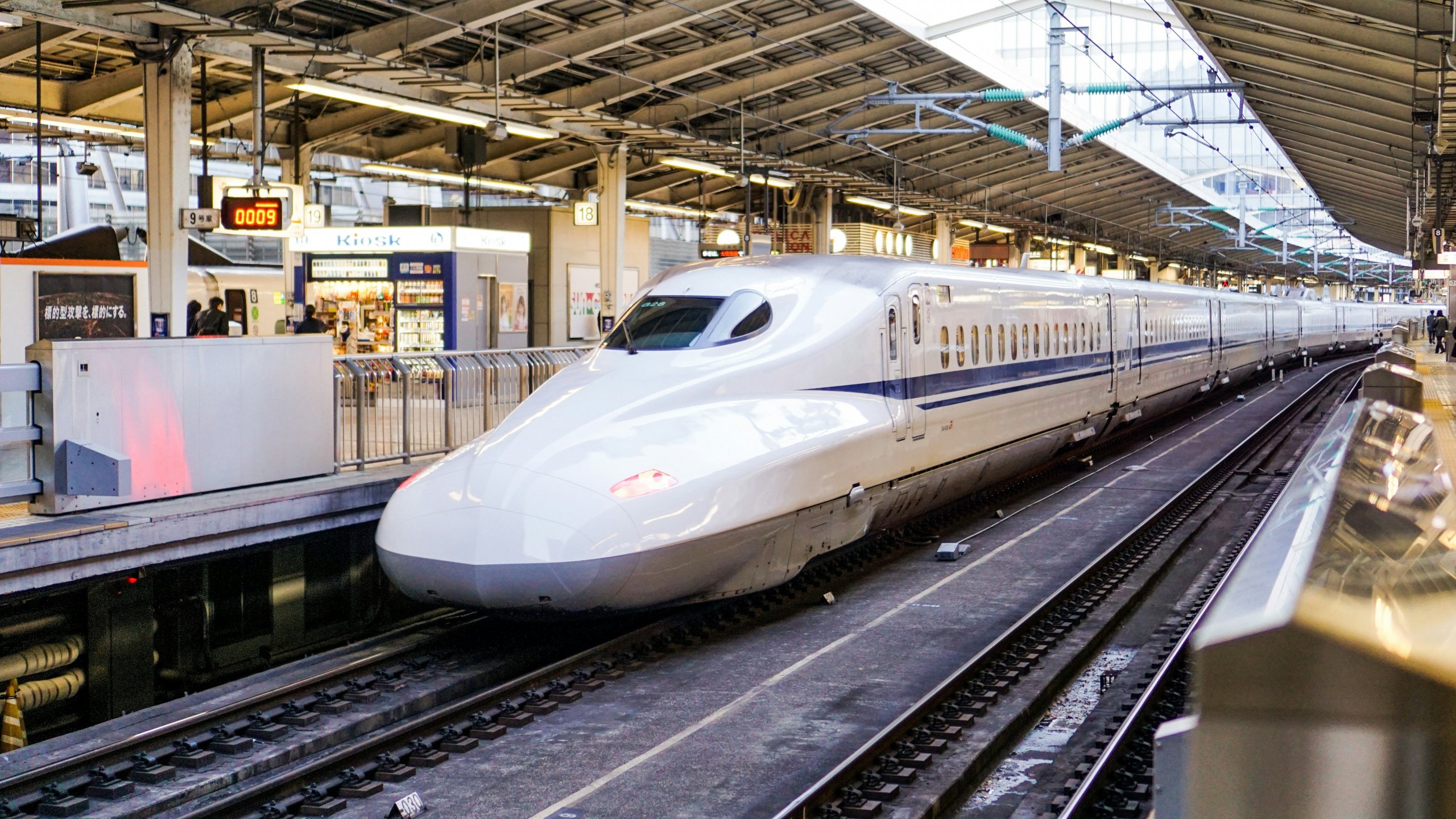Tokyo is renowned for its technological advancement, and its public transit system is no exception. Tokyo’s Transit System is the largest in the world, reflecting Japan’s shinto-centered obsession with cleanliness and efficiency. The three-tier system consists of underground subways, local trains, and Shinkansen bullet trains. The railway and Tokyo Metro are renowned for their punctuality, cleanliness, and comprehensiveness. Together, these options provide seamless connectivity to almost every corner of the city and its surrounding areas. We LOVE the personal high-touch service of Tokyo’s public transportation network and feel this to be just another example of Japan’s service-oriented, forward-thinking culture.

Tokyo Metro
The Tokyo Metro is an underground subway system with nine lines, each color-coded for convenience, connecting 190 stations. Most commonly used for travelling between north and west Tokyo to eastern neighborhoods across the Sumida River, the Tokyo Metro network covers the area inside the Yamanote loop as well as areas surrounding Ginza and east of this loop. With modern amenities and user-friendly signage, navigating the Tokyo Metro is an integral part of the city’s transit fabric. Of special note are the “women-only” cars, which operate during morning rush hour (starting around 9:30 AM) to provide security for all women and young children. These cars, along with designated boarding areas, are clearly marked with the “women-only” signage.
Navigating the Tokyo Metro is relatively simple as each station is conveniently labelled by number. Station numbers consist of a color-coded circle (representing the subway line), station number (shown on the subway route map), and alphabet letter (abbreviated symbol of the line name).
Service
All subways operate from 5:00 AM – 12:00 AM. On major lines during rush hour, trains come every 2-3 minutes. Though there are many different ticket options depending on route and use duration, the best option for travelers is the Tokyo Metro 24-hour ticket, which allows unlimited rides across all lines for the day. These can be purchased using ticket machines at all stations at the rate of 600 JPY (about 4.00 USD) for adults or 300 JPY (about 2.00 USD) for children.
Popular Stations
The most commonly travelled Metro stations are Ginza, Asakusa, Meiji-jingumae (Harajuku), Shibuya, Shinjuku, and Ueno, which all provide easy access to some of our favorite stopover destinations:
Ginza Station: Shopping in Ginza District (!) with our favorite, Ginza Atoya
Asakusa Station: Sensoji Moss Temple
Meiji-jingumae Station: Meiji Shrine, Harajuku District, Omotesando Area
Shibuya Station: Shibuya Crossing
Shinjuku Station: Shinjuku Gyoen National Garden
Ueno Station: Tokyo National Museum, Ueno Zoo


JR East Japan Railway – Local Railway Trains
The East Japan Railway Company, commonly known as JR East, is the backbone of Tokyo’s transit system. Operated by the JR Group, JR East is the largest of the group’s seven railway companies across the country, with an annual ridership of approximately six billion people. The company was formed in 1987, when JNR (Japan National Railways, the previous railway system wholly owned by the Japanese government) privatized, splitting public transit to individual companies. Though JR East comprises an extensive network of 23 lines spanning the greater Tokyo area, the Yamanote Line is definitely the primary route visitors and locals use for getting around the city. On a map, Yamanote appears as a green loop connecting the city’s major hubs, including Tokyo Station, Shibuya, Ginza, Akhabara, Shinjuku, Harajuku, and more.
Service
Trains run from approximately 4:30 AM – 1:00 AM in two-to-four minute intervals. With few exceptions, trains primarily operate above ground. Though there are many different ticket options depending on route and use duration, the best option for travelers is the basic fare ticket, which allows access to all local train lines, though price varies depending on travel duration. Alternatively, for repeated use, we suggest a reloadable Suica (IC) card, which is a basic fare ticket that you top off beforehand. These can be purchased using ticket machines at most stations.

JR East Japan Railway – Shinkansen (Bullet Trains)
The Shinkansen (bullet) transport system part of the larger JR East transit system, which also includes conventional local railway lines and limited express trains. The Shinkansen is refreshingly efficient, immaculately clean, very fast, and completely reliable. If only we had Shinkansen in the states! We particularly love the Shinkansen/Bullet Train Nozomi First Class N700 Green Cars featuring ergonomic seating and tilting technology for an unbelievably smooth ride. Recently celebrating 53 years of service, Japan’s Shinkansen can rightfully boast of having the best safety record on the planet, having served seven-billion passengers without a single passenger fatality due to collision or derailment. On top of this pristine system, the importance of punctuality in Japanese culture can be witnessed in its impeccable train schedule, with departures and arrivals on time down to the second. It is known that you can actually tell the time simply by noting when a train is departing, no need to find a clock! It is so rare for a train to be behind schedule, that if it ever happens, it is assumed there was a natural disaster or similar circumstance involved to cause such an odd occurrence.
Service
To ride the Shinkansen, all travelers will need to purchase a basic fare ticket in addition to a (limited) express train seat ticket (reserved or non-reserved). These can be purchased via ticketing machines at train stations, at travel service centers throughout Tokyo, or by pre-reservation online at https://www.eki-net.com/en/jreast-train-reservation/Top/Index.

